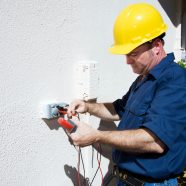Energy Management in a Commercial Environment: Why and How
Energy costs can be a huge item in your P&L statement. Here in south Florida it’s even more intense because of the power demand caused by using air conditioning throughout most of the year. These extra energy costs represent money you can better spend on running or improving your business. This is why it’s crucial for you to practice good energy management habits, and to teach your employees to do the same.
Energy management is a system of practices that reduce energy costs across the board. They can be simple set-it-and-forget-it ideas or common practices, but the one thing they all have in common is that they save money and reduce your business’ power usage.
Why Bother With Energy Management?
If you’re not running a factory or other large business, can the savings be great enough to justify the extra time and effort? In fact, there are two reasons to use an energy management system, both of which will show different benefits for your business.
Practicing energy conservation for savings can add up over time. By putting multiple techniques into practice you may save fewer than a hundred dollars a month, but that be a significant savings by the year’s end. This can make a big difference for a business that’s running on a 1-2 percent profit margin.
The other side of the energy conservation picture is doing good for your community. When you cut down on your energy usage, you’re reducing your carbon footprint. The less energy you and other businesses use, the better it is for the environment. You’ll be doing good for the world, plus earning the respect of potential customers who value companies with a social conscience.
How to Save Energy in Your Business
Manage your energy use by upgrading your equipment as well as developing new practices in your business. Begin with small steps like changing all the light bulbs in your building to energy efficient LED bulbs. They only use about 10 percent of the power of traditional bulbs, plus they give off less heat, which is good for any business that needs to constantly cool the building. Include your outdoor lighting and the lights in your security system in this energy makeover. LED lights are just as bright as incandescent or fluorescent types, giving you the same bright security lighting profile.
Have timers installed on all your electrical equipment, both inside and out. This will eliminate wasted power from people forgetting to turn off lights or equipment. You can add individual timers for small items such as desk lamps, but it’s best to get a licensed electrician to install timers for your main lighting and equipment systems. A commercial electrical West Palm Beach contractor will not only be able to correctly install the timers the first time, he can also arrange a maintenance schedule for taking care of all the electrical equipment in the building.
When it comes time to replace old and worn-out equipment, always check the energy ratings to find the one that uses the least power. Energy efficient machines, even those that initially cost more to install, can be cheaper to use over its lifespan.
Manage standby power usage by requiring that all employees unplug equipment when they’re done using it. Machines with an internal clock or standby setting, such as coffee makers and printers, will drain power even when they’re not in use. These so-called energy vampires can drain a significant amount of power in 24 hours without ever being touched. Make unplugging a habit throughout your business.
Involve your employees in your efforts to reduce power. Reward innovation when it comes to saving energy. If you instill a sense of pride in your team because they’re doing good for the environment, they’ll be more likely to help you in your energy management efforts.
Read MoreAlternative Energy Trends in South Florida
About 90 percent of the power used in south Florida homes is electric, with the majority of that being created by burning coal or natural gas. The call for renewable energy sources is growing, for energy conservation as well as economic reasons. Alternative energy sources aren’t as common in south Florida as they are in other parts of the country, but installations are on the rise, revealing a brighter future for renewable energy in this part of the state.
Alternative energy isn’t just the province of new construction. Home remodels and business renovations in south Florida can be the perfect time to add an alternative, cleaner source of power to your building. Depending on your environment, you have multiple options to consider:
- Solar power can provide up to 100 percent of your daily power needs
- Wind energy is completely clean, but not as effective in this area
- Kinetic energy is a new technology with an exciting future
Solar Power
You would think that solar power in Florida would be a natural part of green building. After all, we’re known as the sunshine state. In past years, though, homeowners and business owners have been forced to pay fees to power companies even if their solar panel array produces all the power they use. In essence, everyone in the state was forced to pay for being hooked up to a power company, even if they never used it.
Today, a combination of energy conservation lobbying and financial incentives in the form of substantial tax breaks are making solar energy a better bargain for south Florida residents. While it can take years for a full panel array to pay for itself in saved energy costs, the fact that solar energy doesn’t add to greenhouse gases can tip the scales when deciding to install panels.
Wind Energy
Compared to the great plains of Kansas and Wyoming, south Florida doesn’t have a steady supply of strong winds to count on. Many wind generators are needed in a given area to produce useful amounts of electricity because of the relatively ineffective technology available. The numbers for this get more attractive for wind turbines placed over the water and on extra-high poles that catch stronger air currents, but in south Florida this is only possible for residents with large plots of land or long water frontage.
Kinetic Energy
One of the most exciting new concepts in green building for the south Florida area is using kinetic energy to produce electrical power. For residents who have property on the water, this can be a solid source to rely on in years to come. Kinetic energy power plants are small, floating machines that are anchored to the sea bed. Attached to the ground with a cable, these machines, housed in pods, bob up and down with the waves. Every time the pod goes up or down, it creates a small amount of energy that can be stored to be used later. Some brands include small water wheels that increase the electrical output, while others are simple passive systems with levers that move with the waves.
A kinetic energy production field requires multiple pods installed in the water, so it’s obviously only useful for residents with water frontage, but it’s growing in popularity in some communities for the production of municipal power as well as for individual owners.
Read MoreCost Implications of a Residential Rewiring Project in South Florida
Older homes, like many in the south Florida area, often need a complete residential rewiring to keep them safe and up to code. If your home is more than 50 years old, it’s time to consider contacting a professional electrical contractor to inspect the condition of your home’s wiring. Even if age isn’t a consideration yet, there are other signs that indicate you need to have your wiring inspected. Look for:
- A faint burning smell or sizzling sound, especially when appliances are turned on
- Circuit breakers that trip or fuses that blow on a frequent basis
- Brown discoloration on switches and outlets and the walls around them
Residential rewiring isn’t a minor job, and the cost depends on many variables. It’s a serious renovation job, but in many instances there are ways to minimize the costs.
The Home Rewiring Process
Rewiring your home involves removing all the old wiring and replacing it with newer, non-metallic wire. This new wire doesn’t get hot when surrounded with insulation, it’s easier to work with and it’s safer inside your walls.
In the most elaborate wiring jobs, electrical contractors remove the interior walls, replace all the wiring and rebuild the walls with the new wiring inside. This can take a lot of time and can be the most expensive method, as well as doing damage to older, historically significant buildings.
Contractors can replace the wiring using a series of small holes cut into the walls, along with a thin line called fish tape that draws the wire from one small hole to another. This method requires patching holes, but it keeps the integrity of older plaster walls while installing newer, safer wiring. Running wires behind existing walls can be much less expensive than replacing the walls themselves, and can save homeowners thousands of dollars in construction costs.
Residential Rewiring Costs
The price of each part of the job will vary from season to season, but it’s important to remember that many details go into the final cost. It’s not the price of the job itself as much as it is that of each individual part of the job.
Building permits are often the first item you’ll spend money on when having wiring redone. The permits will cost the same whether you or your electrical contractor pulls the permits, but your professional knows which ones you need and won’t waste money on those you don’t.
If you’ve got an older house that still has a fuse box, it will need to have a new circuit breaker installed. This can cost up to $3000, depending on the size of your home’s electrical demand load.
While you can save a bit of money reusing your old switches and outlets, you’ll still have to pay for your contractor to install them. A residential electrical south Florida contractor will charge around $100 per outlet for installation.
The most expensive materials cost is, of course, for the wiring itself. New wire can cost thousands of dollars, even for the smallest home, but it can pay off in peace of mind.
The most important item on your home rewiring job is the cost of a professional electrical contractor. Rewiring your home is never a DIY job; it takes a knowledgeable professional to safely install an electrical system that will last for decades.
Read More



Recent Comments